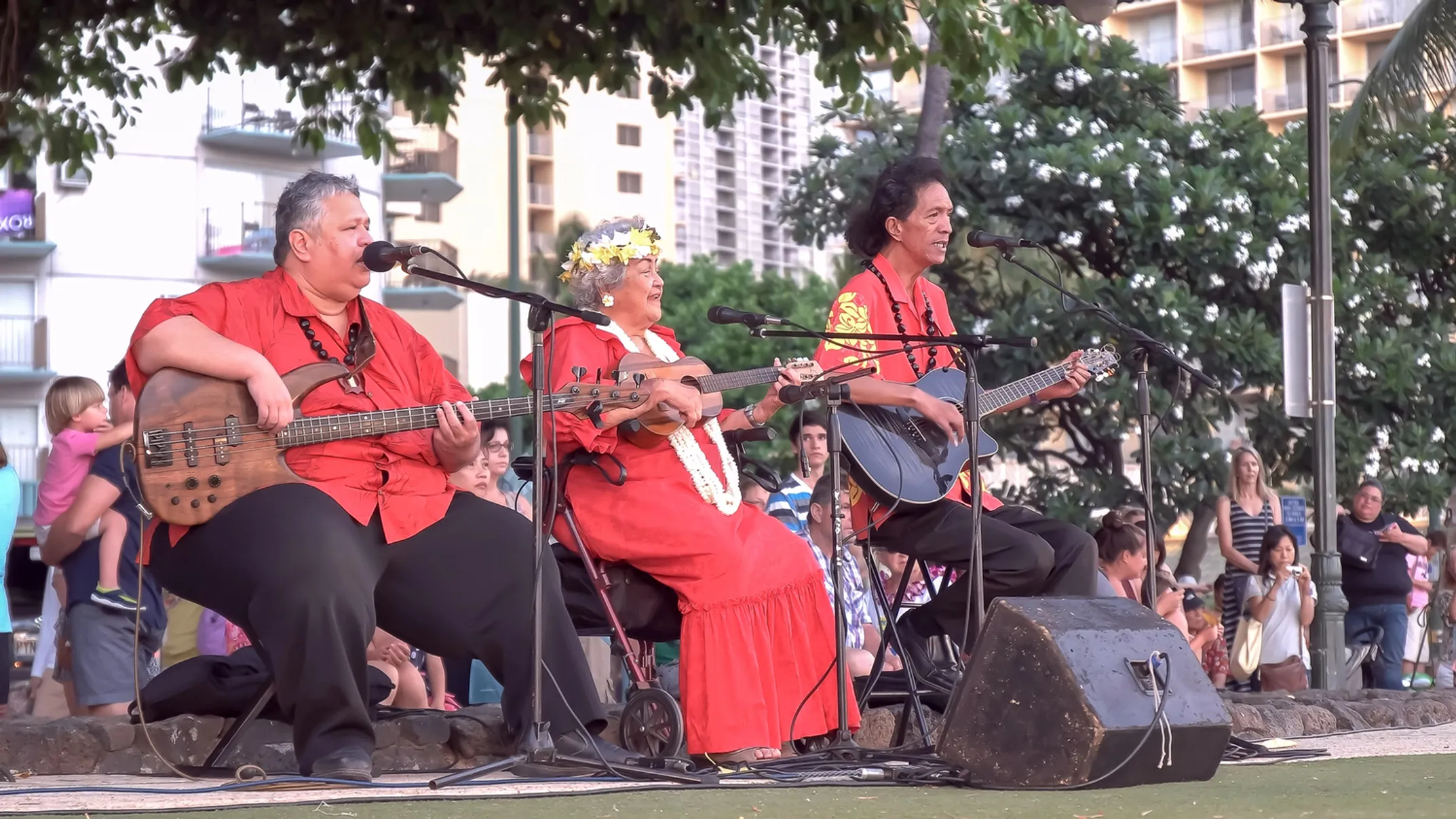

The Grammar of Respect
Protocols and Forms of Hawaiian Chant

Written by a Cultural Practitioner
Kalani MillerPart II: The Grammar of Respect: Protocols and Forms
The Reciprocal Dialogue: Kāhea, Komo, Mahalo
The use of oli follows a grammar of respect, protocols that ensure interactions happen in pono—balance and correctness. The most basic is the ritual of entry, formal call-and-response that embodies the cultural value of reciprocity.
The Sacred Exchange
This call-and-response structure isn't limited to human interactions. It extends to relationships between people and the ʻāina itself. This reveals a worldview where all entities possess agency and must be approached with respect, not assumed access.
The protocol is living, ritualized negotiation that constantly reinforces balanced and reciprocal relationship between humans and their environment—powerful counter-narrative to Western concept of land as passive resource.
While these are primary forms, the tradition is rich with diverse styles, including rapid, conversational kepakepa and more melodic olioli, which often features ʻiʻi, distinctive vocal vibrato.
Five Oli Misappropriations That Break Our Kapu (Sacred Laws)
As someone who's witnessed too many hotel luaus and "authentic" cultural shows, I need to share how the commercialization of Hawaiian culture for tourism often violates the kapu that protect oli's integrity.
⚠️ Chanting without Context
The most common offense is reducing oli to generic opening act for luau or show. An oli is composed for specific purpose. Using oli komo without preceding oli kāhea is like answering a question that was never asked.
⚠️ Ignoring Kaona
Presenting chant with only its most literal, surface-level translation for tourist consumption strips it of its soul. It ignores deep layers of history, genealogy, and poetic metaphor that give oli its true power.
⚠️ Performing Sacred Chants in Profane Spaces
Chants composed for heiau temple, royal ceremony, or sacred natural site hold immense power tied to that specific location. Performing them in noisy, commercial, or disrespectful environment is profound desecration.
⚠️ The Lack of Reciprocity
In proper context, the audience isn't passive consumer. They're participants in sacred exchange, their respectful attention—hāmau, or silence—being their offering. In many tourist settings, this understanding is completely lost.
⚠️ Chanting without Kuleana (Responsibility)
The right to perform oli comes with immense kuleana—responsibility and privilege earned through rigorous training, deep knowledge, and connection to legitimate lineage of teachers. When performers without this foundation chant the words, oli becomes empty shell.
Five Foundational Chants: A Gateway for the Seeker
To move beyond abstract concepts, here are tangible examples of oli, offering gateway into Hawaiian worldview. These five foundational chants are each pillars of the tradition.
E Hō Mai
Composed by Edith Kanākaʻole
Hawaiian:
E hō mai ka ʻike mai luna mai ē
O nā mea huna noʻeau o nā mele ē
E hō mai, e hō mai, e hō mai ē
English:
Grant us the knowledge from above
Concerning the hidden wisdom of the chants
Grant us, grant us, grant us these things
This powerful chant is plea for knowledge and inspiration from the divine. It's commonly used to begin class, meeting, or any undertaking to clear the mind of negativity, focus the group's collective energy, and ask for guidance from ancestors.
Oli Aloha
Traditional, from Mary Kawena Pukui Collection
Hawaiian:
Onaona i ka hala me ka lehua
He hale lehua nō ia na ka noe
ʻO kaʻu nō ia e ʻanoʻi nei
E liʻa nei hoʻi o ka hiki mai
A hiki mai nō ʻoe
A hiki pū nō me ke aloha
Aloha ē, aloha ē, aloha ē
English:
Fragrant with the breath of hala and lehua
A house of lehua for the mist
This is the sight I long to see
Longing for your arrival
Now that you have come
Love comes with you
Greetings, greetings, greetings
This classic welcoming chant expresses pure aloha. The kaona is rich with natural imagery. The fragrance of hala and lehua flowers represents beauty and spirit of host and land. It's profound expression of hospitality.
Aia O Pele I Hawaiʻi
Traditional
Hawaiian:
Aia lā ʻo Pele i Hawaiʻi, ʻeā
Ke haʻa mai la i Maukele, ʻeā
ʻUhīʻūhā mai ana, ʻeā
Ke nome aʻe la iʻā Puna, ʻeā
Haʻina ʻia mai ka puana, ʻeā
No Hiʻiaka nō he inoa, ʻeā
English:
There is Pele in Hawaiʻi, yes
She is dancing at Maukele, yes
She surges and puffs this way, yes
Devouring the land of Puna, yes
Tell the refrain, yes
For Hiʻiaka is the name, yes
This foundational chant in hula kahiko study is name song for Pele's sister, Hiʻiaka, but its kaona describes raw power of Pele herself as she "dances" across land, her movements creating and destroying. It tells part of epic story where Pele, in jealous rage, breaks her promise and destroys beloved forest of her friend Hōpoe, key event in the Pele and Hiʻiaka saga.
Oli Mahalo
Composed by Kumu Kēhau Camara
Hawaiian:
ʻUhola ʻia ka makaloa lā
Pūʻai i ke aloha ā
Kūkaʻi ʻia ka hāloa lā
Pāwehi mai nā lehua
Mai ka hoʻokuʻi a ka hālāwai lā
Mahalo e nā akua
Mahalo e nā kūpuna lā ʻeā
Mahalo me ke aloha lā
English:
The fine makaloa mat is unfurled
In love, food was shared
The everlasting breath has been exchanged
Adorned with lehua flowers
From zenith to horizon
Gratitude to the gods
Gratitude to the beloved ancestors
Thanks with love
An oli of profound gratitude, this chant gives thanks after event or sharing of knowledge. The makaloa is finest of woven mats, symbolizing precious and honored space. "Exchanging the everlasting breath" refers to sharing life force and knowledge. It's formal thank you to the divine, ancestors, and all present for generosity and love that has been shared.
E Laka E
Traditional
Hawaiian:
Pūpū weuweu e Laka ē
E Laka i ka leo
E Laka i ka loaʻa
E Laka i ka waiwai
E Laka i nā mea a pau
English:
O wildwood bouquet, O Laka
O Laka, queen of the voice
O Laka, giver of gifts
O Laka, giver of bounty
O Laka, giver of all things
This prayer of adoration to Laka, patron goddess of hula, calls the "wildwood bouquet" referring to forest greenery gathered as offerings to adorn her altar. The chant asks Laka for her blessings: clear and powerful voice, gifts and talents, abundance and prosperity. It's direct appeal for hoʻoulu inspiration, acknowledging Laka as source of all creative expression in hula.
Continue Your Journey
Discover how Hawaiian chant survived near-extinction and thrives today
📋 Protocol Steps
- 1 Offer Oli Kāhea (Request entry)
- 2 Receive Oli Komo (Permission granted)
- 3 Participate with Hāmau (Respectful silence)
- 4 Offer Oli Mahalo (Gratitude)
🎵 Chant Styles
Rapid, conversational style
Melodic with ʻiʻi vibrato
Controlled voice break
🔮 Sacred Concepts
- Pono: Balance and correctness
- Kuleana: Responsibility/privilege
- Hāmau: Sacred silence
- Mahaʻoi: Rude presumption

